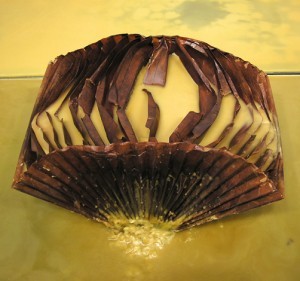Mario Merz
02 Nov - 22 Dec 2007
MARIO MERZ
"The Magnolia Table "
Sperone Westwater is pleased to announce an exhibition of vintage works by Italian artist, Mario Merz (1925-2003). The exhibition features large-scale sculptures produced between the early 1970s and early 1980s.
Merz was influenced by his father, an inventor and engineer, who imparted an innate fascination for science and mathematics. After completing two years in medical school, he refocused his efforts toward creating an alchemical art that incorporated these disciplines with nature and found materials. This process became the syntax of Merz's vernacular. When the artist passed away in 2003, he left behind an impressive legacy of creativity and an expansive breadth of work.
The earliest sculpture in this exhibition, the azure neon Untitled (1971), is one of the first representations by the artist of the Fibonacci principle - a numerical sequence in which each number is the sum of the previous two numbers. In this work, the neon rings encircle the individual numbers 1, 1, 2, 3, 5, gradually expanding as they flourish up the wall and proliferate towards infinity. Merz drew considerable inspiration from the potential of this algorithm to quantify the overlying structure of the universe. This premise can also be noted in spiral formations, evident in the sculpture, Tavola a spirale (Spiral Table), an assortment of branches, fruit, and vegetables placed on the coils of a glass spiral made in 1982. As the structure radiates from its’ locus point, it translates the organic progression of this principle in nature.
The title of the show is inspired by the largest sculpture, Quattro Tavole in Forma di Foglie di Magnolia (1985), literally ‘Four Tables in the Shape of Magnolia Leaves.’ It consists of a row of steel-framed tables, each topped with a thick layer of beeswax and embedded with shells, pinecones, leaves and branches, as well as a solid wax cone that bisects the horizontal plane. Further exemplifying his talent for incorporating a variety of materials is Pianissimo (very slowly, very softly), a glass and steel cabinet made in 1984 that elegantly cages a convergence of beeswax and pinecone. These sculptures were prominent in the artist’s major retrospective at the Guggenheim Museum, New York, in 1989.
Merz began his career in Torino where he spent his formative years in opposition to fascism, Consequently, he was imprisoned as a subversive person. The industrial climate of the city gave rise to the interchangeable association of natural environment and architecture, consistently prevalent in the evolution of his works. After 1968, Merz became a leader in the Arte Povera group, an association of Italian artists collectively bound by a shared anti-elitist aesthetic and the incorporation of accessible materials, debris from both the natural and inorganic worlds.
This exhibition marks Merz’s seventh solo exhibition at Sperone Westwater and will be commemorated with an extensive catalogue featuring an essay by Emily Braun, Ph.D., Distinguished Professor of Art History, Hunter College and the Graduate Center, CUNY and a specialist in modern Italian art and culture.
"The Magnolia Table "
Sperone Westwater is pleased to announce an exhibition of vintage works by Italian artist, Mario Merz (1925-2003). The exhibition features large-scale sculptures produced between the early 1970s and early 1980s.
Merz was influenced by his father, an inventor and engineer, who imparted an innate fascination for science and mathematics. After completing two years in medical school, he refocused his efforts toward creating an alchemical art that incorporated these disciplines with nature and found materials. This process became the syntax of Merz's vernacular. When the artist passed away in 2003, he left behind an impressive legacy of creativity and an expansive breadth of work.
The earliest sculpture in this exhibition, the azure neon Untitled (1971), is one of the first representations by the artist of the Fibonacci principle - a numerical sequence in which each number is the sum of the previous two numbers. In this work, the neon rings encircle the individual numbers 1, 1, 2, 3, 5, gradually expanding as they flourish up the wall and proliferate towards infinity. Merz drew considerable inspiration from the potential of this algorithm to quantify the overlying structure of the universe. This premise can also be noted in spiral formations, evident in the sculpture, Tavola a spirale (Spiral Table), an assortment of branches, fruit, and vegetables placed on the coils of a glass spiral made in 1982. As the structure radiates from its’ locus point, it translates the organic progression of this principle in nature.
The title of the show is inspired by the largest sculpture, Quattro Tavole in Forma di Foglie di Magnolia (1985), literally ‘Four Tables in the Shape of Magnolia Leaves.’ It consists of a row of steel-framed tables, each topped with a thick layer of beeswax and embedded with shells, pinecones, leaves and branches, as well as a solid wax cone that bisects the horizontal plane. Further exemplifying his talent for incorporating a variety of materials is Pianissimo (very slowly, very softly), a glass and steel cabinet made in 1984 that elegantly cages a convergence of beeswax and pinecone. These sculptures were prominent in the artist’s major retrospective at the Guggenheim Museum, New York, in 1989.
Merz began his career in Torino where he spent his formative years in opposition to fascism, Consequently, he was imprisoned as a subversive person. The industrial climate of the city gave rise to the interchangeable association of natural environment and architecture, consistently prevalent in the evolution of his works. After 1968, Merz became a leader in the Arte Povera group, an association of Italian artists collectively bound by a shared anti-elitist aesthetic and the incorporation of accessible materials, debris from both the natural and inorganic worlds.
This exhibition marks Merz’s seventh solo exhibition at Sperone Westwater and will be commemorated with an extensive catalogue featuring an essay by Emily Braun, Ph.D., Distinguished Professor of Art History, Hunter College and the Graduate Center, CUNY and a specialist in modern Italian art and culture.

